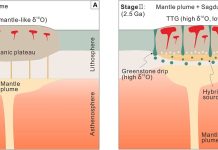
The oceans of our world seem permanent through the lens of a human lifespan, but they are anything but.
They go through a lifecycle of birth, expansion, and eventual closure, a process that unfolds over hundreds of millions of years. This process is known as the Wilson Cycle.
For instance, the Atlantic Ocean, which emerged when the supercontinent Pangea split apart about 180 million years ago, is also destined to close someday.
Similarly, the Mediterranean Sea is all that remains of the once vast Tethys Ocean that lay between Africa and Eurasia.
A crucial step for an ocean to transition from expansion to closure is the formation of new subduction zones. These zones occur where one tectonic plate starts sinking beneath another.
However, creating new subduction zones is challenging because it requires the plates to break and bend, despite their incredible strength.
A recent study has provided a solution to this dilemma by suggesting that subduction zones can shift from older, shrinking oceans to newer ones. This concept is referred to as “subduction invasion.”
This groundbreaking study, utilizing advanced computational models, has made a startling prediction: a subduction zone beneath the Gibraltar Strait is on the move, extending into the Atlantic Ocean.
This movement is expected to lead to the development of an Atlantic subduction system, essentially creating an Atlantic version of the Pacific’s “Ring of Fire.”
This significant geological shift is anticipated to occur “soon” in geological terms, which means in about 20 million years.
The formation and migration of subduction zones are complex, requiring sophisticated three-dimensional modeling techniques and the power of supercomputers to understand.
This research has not only managed to detail the formation of the Gibraltar Arc but also predicts its future progression.
The study indicates that the currently slow-moving Gibraltar subduction zone will, after 20 million years, quicken its pace and begin to consume the eastern side of the Atlantic’s crust, marking the start of the ocean’s closure.
This revelation is particularly intriguing when considering that other subduction zones, such as those near the Lesser Antilles in the Caribbean and the Scotia Arc near Antarctica, have already migrated into the Atlantic millions of years ago.
The study of the Gibraltar subduction offers a unique opportunity to observe such a process in its initial stages.
The implications of this study extend beyond academic interest. Subduction zones are notorious for generating some of the most powerful earthquakes.
The activity of the Gibraltar subduction zone suggests that the region could experience significant seismic events in the future, similar to the devastating 1755 Great Lisbon Earthquake. This highlights the need for preparedness in the face of natural disasters.
This research not only sheds light on the dynamic nature of our planet’s geological processes but also underscores the importance of understanding subduction zones.
As these zones play a crucial role in the Earth’s geological evolution, studying them helps us prepare for the seismic risks they pose.
The findings have been published in the journal Geology, offering a new perspective on the future of the Atlantic Ocean and the seismic activity in the surrounding regions.
The research findings can be found in Geology.
Copyright © 2024 Knowridge Science Report. All rights reserved.



